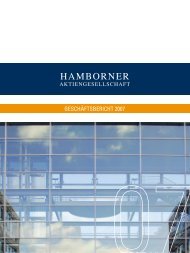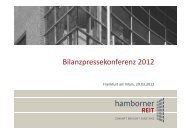annual report 2009 - bei der Hamborner REIT AG
annual report 2009 - bei der Hamborner REIT AG
annual report 2009 - bei der Hamborner REIT AG
Create successful ePaper yourself
Turn your PDF publications into a flip-book with our unique Google optimized e-Paper software.
Land charges to the extent of €114.2 million<br />
chargeable to the company were entered on<br />
December 31, <strong>2009</strong>.<br />
The company had a line of credit amounting to<br />
€3 million up to December 31, <strong>2009</strong>, which was<br />
secured by a further land charge. The credit line<br />
arrangement expired as of December 31, <strong>2009</strong>.<br />
The land charge certificate has been returned to<br />
us in the meantime.<br />
to our sHareHol<strong>der</strong>s management <strong>report</strong> Financial statements supplementary inFormation<br />
in T€ December 31, <strong>2009</strong> December 31, 2008<br />
long-term short-term long-term short-term<br />
Financial liabilities 101,218 4,609 81,543 3,754<br />
Derivative financial instruments 7,834 11 5,807 0<br />
Total 109,052 4,620 87,350 3,754<br />
The financial liabilities bear interest at interest rates<br />
of between 4.41% and 5.21%. The redemptions<br />
are effected quarterly, half-yearly or <strong>annual</strong>ly commensurate<br />
with the loan agreements.<br />
Contractually agreed redemption payments:<br />
in T€ Dec 31, <strong>2009</strong> Dec 31, 2008<br />
Financial liabilities<br />
of which<br />
payable within one<br />
year 4,620 3,754<br />
payable within two<br />
to five years 27,235 12,153<br />
payable after five<br />
years 81,817 69,390<br />
Total 113,672 85,297<br />
HAMBORNER is exposed to various risks due to its<br />
business activity. The risk <strong>report</strong>, which is part of<br />
the management <strong>report</strong>, includes a detailed presentation<br />
of these risks and their management.<br />
Derivative financial instruments in the form of<br />
interest rate swaps are used in the main for the<br />
management of interest rate risks. The risks resulting<br />
in connection with the use of these <strong>der</strong>ivative<br />
financial instruments are the subject of risk manage-<br />
ment and control.<br />
The risks resulting from the financial instruments<br />
relate to credit, liquidity and market risks. Credit<br />
risks exist in the form of risks of default for financial<br />
assets. This risk subsists to the extent of the<br />
book values of the financial assets as a maximum.<br />
For <strong>der</strong>ivatives, this is the sum of all the positive<br />
market values and, for primary financial instruments,<br />
the sum of the book values. If risks of default exist,<br />
they are taken into account by means of value<br />
adjustments.<br />
Liquidity risks constitute refinancing risks and<br />
thus risks of a fulfilment of existing obligations to<br />
pay when due. The strategy and the results of the<br />
planning process are taken as a basis for the early<br />
identification of the future liquidity situation. The<br />
expected liquidity requirements are scheduled in<br />
the medium-term plan, which covers a period of<br />
five years.<br />
The current liquidity requirements are compared<br />
with the actual data by means of daily, weekly and<br />
monthly budgetary accounts.<br />
Sensitivity analyses are required for the presentation<br />
of market risks in accordance with IFRS 7. Both<br />
influences on the result as well as on the equity<br />
capital are to be shown through hypothetical changes<br />
in risk variables orientated to the past. Interest rate<br />
risks in particular are relevant for HAMBORNER in<br />
this regard.<br />
<strong>annual</strong> <strong>report</strong> <strong>2009</strong> | <strong>Hamborner</strong> reit ag<br />
89





